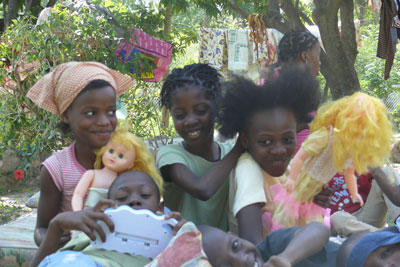Haiti Earthquake Appeal: Resources for Schools

Here is some material put together to help children in school understand and come to terms with what has happened in Haiti
See also Haiti Earthquake Appeal
As a schools charity, running more than 190 schools in the developing world including several in Haiti we are conscious that younger children are being upset by news of what has been happening in Haiti and we have put together a few positive resources to help teachers explain that life can carry on after even the worse disaster. We will be improving this page with help from volunteers, do email us with suggestions. There is plenty of material online on the negative experience which people have had.
Here is a picture of some girls in our village. They are too scared to go indoors because of all the buildings collapsing so their mother has brought mattresses outside. But they are still children and are having fund with their dolls on the mattresses!
First, for context, see our schools in Haiti for an explanation of the school day. Children may be interested in the idea that there is so much demand for school places that we have been running "two turns" or "two shifts" with children either doing morning or afternoon school. The picture of children in front of a world map and in uniform could help underlining our common world citizenship with these children.
Here is a picture of the school after the earthquake. It is still standing but lessons are cancelled and it is being refitted rapidly to become a safe shelter for children who have lost their parents in the earthquake.
You can emphasise that most children who have lost their families and are alone will to reunited to them eventually. There are roughly a million affected children but realistic estimates are that 99.5% of these children will still have a parent somewhere looking for them. After these kind of emergencies we typically take in some 5,000-10,000 children in safe shelters, sometimes put there by their mum or dad whilst they hunt for other relatives or somewhere to live. Parents leave their children because they know they will be safe.
Children who do get orphaned most often end up living with grandparents, aunts and so on. We provide help for struggling relatives to ensure they can manage to offer some kind of family life to these children.
The remaining children with no one still have possible happy endings. Here is an example of earthquake orphans from Kashmir who have ended up happily cared for. You can discuss this kind of positive example with younger children who may be upset.
We also have a poster here to highlight and remind children of these kind of positive examples.

 Return to Schools Wikipedia Home page…
Return to Schools Wikipedia Home page…
